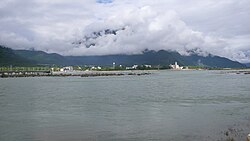Bayi District
|
Bayi 巴宜区 • བྲག་ཡིབ་ཆུས། |
|
|---|---|
| District | |

View of Bayi Town from the Nyang River
|
|
 Location of Bayi District (red) in Nyingchi (yellow) and the TAR |
|
| Location of the seat in the Tibet AR | |
| Coordinates: 30°17′06″N 94°40′17″E / 30.28500°N 94.67139°E | |
| Country | People's Republic of China |
| Region | Tibet |
| Prefecture-level city | Nyingchi |
| District seat | Bayi Town |
| Time zone | China Standard (UTC+8) |
| Bayi | |||||||
| Chinese name | |||||||
|---|---|---|---|---|---|---|---|
| Chinese | 巴宜 | ||||||
|
|||||||
| Tibetan name | |||||||
| Tibetan | བྲག་ཡིབ། | ||||||
|
|||||||
| Transcriptions | |
|---|---|
| Standard Mandarin | |
| Hanyu Pinyin | Bāyí |
| Transcriptions | |
|---|---|
| Wylie | brag yib |
| Tibetan Pinyin | Bayi |
Bayi District, formerly Nyingchi County, is a District of Nyingchi in the Tibet Autonomous Region. Bayi Town, the administrative capital of Nyingchi, is located within the district.
Bayi is located in the middle reaches of the Yarlung Tsangpo River. Both steep cliffs and flat valleys exist in the area. The average altitude is 3000 metres above sea level. "The lowest places are just around 1,000 metres above sea level."
There are many scenic places in or near Bayi.
"The Seche La Mountain Scenic Spot, in the east of Nyingchi County, is a part of the Nyainqentanglha Mountain Range, the watershed of the Nyang River and the Polung Zangbo River. The Sichuan-Tibetan Highway passes by. Standing at the mountain pass at 4,728 meters above sea level, one can admire the sunrise, sea of clouds, endless forest and the grand Namjagbarwa Peak."
Güncang village (Chinese: 更章门巴族乡; pinyin: Gēngzhāng Ménbā zú Xiāng) and Pelung Township by the Sichuan-Tibet Highway are home to the Moinba ethnic group.
Buchu Monastery is located about 28 km (17 mi) south of Bayi Town. Lamaling Monastery is located in Puqu Township.
"The Benri La Mountain near the Dagzê Village on the western slope of the mountain is a sacred site of the Tibetan Bön Sect and one of the four great holy mountains in Tibet." It is located in the southeast of Pulha, north of the Yarlung Tsangpo River. Pilgrimages attract devotees throughout the year. "Every tenth day of the eighth month of the Tibetan calendar, a grand mountain worshiping activity is held, which is called "Nangbolhasoi," meaning "seeking for treasures from immortals." "Each year during the Sagadawa Festival the pilgrims will come to worship and circle around the holy mountain." Seven Bon temples were built around the mountain.
...
Wikipedia

